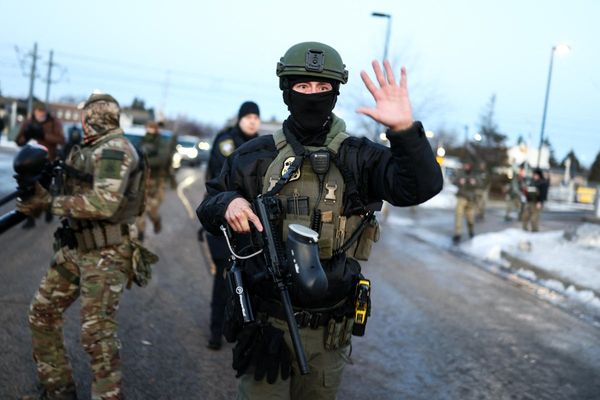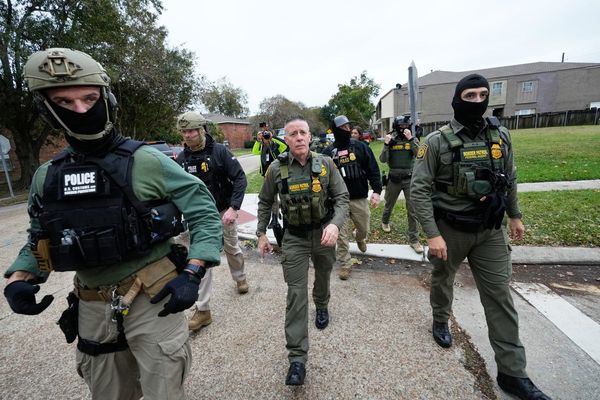
The film begins somewhere outside London, high in a helicopter moving gradually through a bright winter dawn. The trees are bare, an occasional car glints way down on the outskirts below. The ambient thrum of traffic and planes grows louder as the city gets inexorably closer and closer, but so slowly that the audience in the specially constructed cinema in the Serpentine Gallery start to crane and squint to pick out the tower on the dense horizon.
Steve McQueen’s Grenfell takes its time to find the blackened block, rising like a monumental oil rig from the seas of west London before it was covered up. But his film soon locks fast to its subject and the soundtrack abruptly cuts. The camera begins to circle the tower, round and round and around the site where 72 people died on 14 June 2017, in a stark commemorative silence.
The film stares at the evidence: examining the charred architecture, sunlight shining through empty windows. Occasionally it tilts to reveal a cataclysmic drop – the devastating distance between the flats at the bottom and those where people were trapped way up at the top. Scabbed and encrusted, at times whitened by the light so that it appears skeletal, the tower is both ruin and diagram. A monstrous idea, an inhuman structure in which lives were criminally lost.
A forensics expert appears fleetingly at a window. Rubble bags pile up inside like entrails. The camera swings wide to show neighbouring blocks that look directly at Grenfell, still, and low-lying flats huddling dangerously below. Who might be next?
The motion is dizzying, rightly described in Paul Gilroy’s superb pamphlet essay as a gyre. But motion is all McQueen gives. He does not attempt to see more than can be seen, or to create a requiem for the dead. His is a rite of pure observation, in the guise of a protracted film installation.
A train pulls up at a nearby station. The camera keeps on circling. A solitary bird flies by. Repetition catches itself, testing your ability to keep on watching, and watching. How will it end, this testimony? Sound is the exit. Slowly the thrum of life resumes and the screen goes blank.
McQueen has said that he feared the tower would fade from memory once covered up, and he was determined it never be forgotten. Time and repetition certainly make the sight of it indelible. But his film is deliberately affectless as a consequence. These 24 minutes decant you into the next gallery, where the true memorial can be found: the names upon the wall of all those who died – grandparents, poets, widows, immigrants and refugees, the child of three, the little girl who died all alone. Read these, and linger. Their names will draw the homage of your tears.
Tate Britain’s badly overstuffed pre-Raphaelite blockbuster, The Rossettis, features the four offspring of an Italian political exile in London. Two of them, Maria and William Michael, make no impact (appearing mainly as artist’s models) compared with their sister Christina Rosetti, wintriest of poets, or with their self-aggrandising brother Dante Gabriel. But the show has a mission to present them as a radical quartet.

It opens with a coup: Christina’s poetry lettered in snowy white across the walls, and issuing from hushed speakers through the first gallery. And it ends brilliantly too, with Oliver Reed suitably histrionic in Ken Russell’s 1967 movie Dante’s Inferno. But in between is an oppressive slog. Two hundred exhibits, including cumbersome cabinets, fading manuscripts and turgid letters. For hardcore fans there are even locks of hair from DGR and his muse, the artist Elizabeth Siddal. (Hers continued to grow in the grave, or so Rossetti claimed, retrieving his poems from the coffin after her death.)
Rossetti was barely 20 when he co-founded the pre-Raphaelite Brotherhood in 1848. On the evidence of this show he never grows up. His drawings remain stiff and infantile; his paintings oleaginous and gross. He can’t work out which limb goes where when two people embrace. He can’t pastiche the medieval friezes he adored without something jumping out of place. His cartoons don’t hit the wit, and his monstrous regiment of women appear anything but radical.
From their youth, the Rossettis were obsessed with Dante, Christianity and what Tennyson termed “dreams of fair women”, meaning wistful, melancholy, ailing. The poetry of Christina Rossetti, who published her first collection at the age of 16, is piercingly beautiful – only consider In the Bleak Midwinter – but can be poignantly self-denying. Lovers are exhorted not to love her, not to mourn her, not even to remember her after death.
But the delicacy of her writing is inevitably swept aside by the lurid images that follow. This is an art show, after all. The literary thread may continue – pre-Raphaelite costume drama relies on existing narratives from the Bible, Shakespeare, Boccaccio and so on – with the family members playing the parts. But there is scarcely any distinction here between one story and another (captions prove vital), as if anything could be adjusted for the purposes of painting swooning knights and cataleptic damozels.
The show runs through DGR’s muses. Siddal, daughter of a Hatton Garden cutler, had already modelled for Millais’s Ophelia in a cold bath when Rossetti became obsessed with her (dithering over marriage, though, because of her “lower-class” status). He had already taken up with Fanny Cornforth, employed as his housekeeper, when Siddal died of an overdose.
Both appear almost interchangeable with Jane Morris, wife of William, in the galleries of so-called “stunners”, those white-faced women with heavy jaws, tumescent throats and torrential pre-Freudian tresses. As far as Rossetti is concerned, they can be saint or sinner with a quick change of prop.

And the show, alas, seems to follow suit. Siddal, an independent artist, is represented here with images that most resemble those of the brotherhood, as if she were just another pre-Raphaelite zombie.
There is something mildly schizophrenic about an exhibition that claims Rossetti as a radical and then has to out him as overtly racist. His portraits of black children, specifically those of a boy called Gabriel, are nauseatingly gratuitous. He includes Gabriel among the faces in a bible scene, because “the jet would be invaluable”, he wrote, among all the jewel-bright colours.
But the show feels misconceived almost from the start. It wants to tell a story of its own about family relationships and high-minded ideals that appear fatally compromised by actual behaviour. And it wants us to believe – as the brotherhood did – that its art would change the world, instead of devolving into a style. Christina Rossetti is the lone star here, her words winning out over the images every time.
Star ratings (out of five)
Steve McQueen: Grenfell ★★★
The Rossettis: Radical Romantics ★★







